

![]()
Part 1 | Part 2
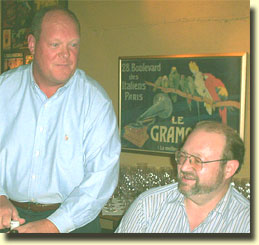 Mishy’s off line tasting consisted of only five people, as there were several last minute
cancellations. I met Paul Campbell
(standing, at right) and his wife Elaine from Minnesota, as well as
Bill
Spohn (seated, at right), a local from the north end of the city.
Mishy’s off line tasting consisted of only five people, as there were several last minute
cancellations. I met Paul Campbell
(standing, at right) and his wife Elaine from Minnesota, as well as
Bill
Spohn (seated, at right), a local from the north end of the city.
The Hamilton Street Grill is located in Vancouver’s Yaletown district. In its hay day, this area experienced an industrial boom. Soon after becoming derelict, developers began
refurbishing many of the abandoned warehouses, transforming the area into a neighborhood of
restaurants, bistros and brew pubs, with hopes of entertaining the upwardly mobile types
who dwell in their nearby loft house condos.
At the Hamilton Street Grill, the Chef, Neil Wyles, took full advantage of the
opportunity to diversify from his regular menu and produced the following degustaion menu for our off
line tasting.
-
Artic Char cerviche with preserved lemon and avocado with chive aioli
-
Juniper and thyme consommé with black truffle dumpling
-
Crab Ravioli with tomato water and goat cheese
-
Tenderloin of pork with a timbale of woodland mushrooms
-
Jumbo prawn with saffron and leek frittata
-
Lamb rack brushed with grainy mustard on carrot rosti
-
Spicy seafood terrine with cilantro and mussel cream
-
Oyster on the half shell with lime and jalapeno slush
-
Poached Angus beef tenderloin with tempura soft shell crab
-
Valrhona chocolate soufflé with Ice wine Anglaise
-
Cheese plate of Stilton, Chevre and double cream Brie
The wines were opened and decanted prior to dinner. We tried to match as many as we could
with the menu. The following are some impressions on the wines and their accompanying
foods.
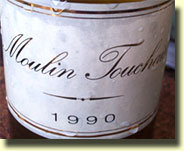 Moulin Touchais 1990: The nose was initially shut down, yet as it opened, it began to show some Seville orange,
apricot compote, candied quince, mango and canned mandarin orange aromas. It was a rich and
oily textured wine, with acids that balanced the residual sugars nicely. As it continued to
open, the nose showed some mineral, chalk and wet stone. Its finish was long, and it
featured much of the bouquet with an additional sweetness of honey and fig. It was a great
match with the Artic Char, simply due to the acidity and sugar balance of the preserved
lemons.
Moulin Touchais 1990: The nose was initially shut down, yet as it opened, it began to show some Seville orange,
apricot compote, candied quince, mango and canned mandarin orange aromas. It was a rich and
oily textured wine, with acids that balanced the residual sugars nicely. As it continued to
open, the nose showed some mineral, chalk and wet stone. Its finish was long, and it
featured much of the bouquet with an additional sweetness of honey and fig. It was a great
match with the Artic Char, simply due to the acidity and sugar balance of the preserved
lemons.
Bonnes Mares Drouhin Laroze 1995: Although I flew into Vancouver carrying it carefully on my lap as to not disturb the
sediment, its colour was somewhat subdued by its cloudy appearance. It was decanted about
forty-five minutes before we drank it. It was to be the first red of the evening to be
matched with the pork tenderloin.
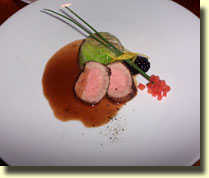 It offered a forceful nose of cedar, black cherry, toffee, caramel, a trace of mint and toasty vanilla. The mid palate was a little tight, although the pork did help to enhance the flavours of plum, dark chocolate, forest floor and morels. Although the dusty tannin on
the finish confirmed its youth, it was drinking really well and married with the wild mushroom component of the pork dish superbly.
It offered a forceful nose of cedar, black cherry, toffee, caramel, a trace of mint and toasty vanilla. The mid palate was a little tight, although the pork did help to enhance the flavours of plum, dark chocolate, forest floor and morels. Although the dusty tannin on
the finish confirmed its youth, it was drinking really well and married with the wild mushroom component of the pork dish superbly.
M. Chapoutier De La Sizeranne Hermitage 1993: Once this had sat in my glass for a while, its alluring nose showed a funky blend of
leather, walnut shell, tar, liquorish, Asian tea, black pepper and porcini mushroom. With
even more time in the glass, a little poo started to make its presence known.
The palate really focused on rich and velvety layers of cassis backed up by a silky dark,
but dusty, streak of chocolate. After about four hours in the glass, when I went to revisit it, holy cow, the funk had turned to wet donkey fur (childhood memory from rainy days
on English beaches) and the poo element had increased quite substantially. It still
displayed some fruit on the palate, but by now, it had started to fade leaving the wine
with an impression of being a tad dried out.
It was a wonderful pairing with the deftly cooked rack of lamb. The grain mustard
complemented the spice elements and the subtle sweetness of the carrot rosti was equal to
the fruit of the wine. Any tannin was tamed by the richness of the protein. A textbook
pairing.
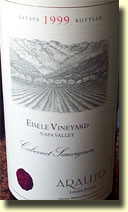 Araujo Cabernet Sauvignon Eisle Vineyard 1999: Having never tasted Araujo before, I was eager to see what the hype was all about. I have
heard both good and bad things about Araujo. I smiled, as fortunately only the good rumors
held true.
Araujo Cabernet Sauvignon Eisle Vineyard 1999: Having never tasted Araujo before, I was eager to see what the hype was all about. I have
heard both good and bad things about Araujo. I smiled, as fortunately only the good rumors
held true.
It showed rich dark fruit, milk chocolate, a trace of tar, dill, vanilla and toast. The
fruit was clearly the principal aroma. The ripeness on the palate was perfect. It delivered blackberry, cassis, thyme, blackcurrant ripple and a hint of coffee grounds. It continued to show more, sip after sip and each layer of fruit became more defined. The long finish
focused on sweet rich black fruit, hints of bracken, a touch of vanilla and Asian spice. It
could be one of the most harmonious Californian Cabernets I have tasted. Paul thought it to
be the wine of the evening. He got no argument from me.
Shafer Cabernet Sauvignon Hillside Select 1999: If this had been poured blind I would swear it was one of those in your face style Ozzie
monsters. Rich sweet red and black fruit aromas flew from the glass, along with sweet oak,
a wisp of green pepper, cake spice and lavender. The mouth was quite spicy and full of
blackberry, cassis and sweet oak. Its finish was long. I did enjoy it, but judging from
comments around the table, it was not showing as well as it potentially should have.
Sine Qua Non Syrah In Flagrante 2000: I am still unsure if this was my wine of the night. As it paired so well with the
tenderloin, it might just take Arauja by a nose. Its rich bouquet delivered blueberry,
blackberry, violet, morel mushroom and moss. A secondary layer rolled out the earthy aroma
of rich black-composted soil moments after a rainstorm. Although it had an amazing
concentration of fruit and its texture was thick and full of glycerin, it managed to be
perfectly harmonized in both flavour and its refreshing degree of acidity.
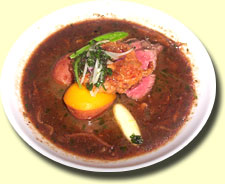 The finish was unfortunately saddening. I was depressed when my glass was empty. It was a
most complete wine that lingered long enough to leave me wanting more for the rest of the
evening. As for the food match, the gently poached Angus tenderloin had just reached the
perfect degree of rareness. The richness of the reduced poaching liquid was in perfect tune
with the wine and the slight saline quality of the battered crab added another dimension
that melded with some of the earthier tones of the wine. This new millennium style of surf and turf and this “kick arse” Syrah sure put a tilt in me
The finish was unfortunately saddening. I was depressed when my glass was empty. It was a
most complete wine that lingered long enough to leave me wanting more for the rest of the
evening. As for the food match, the gently poached Angus tenderloin had just reached the
perfect degree of rareness. The richness of the reduced poaching liquid was in perfect tune
with the wine and the slight saline quality of the battered crab added another dimension
that melded with some of the earthier tones of the wine. This new millennium style of surf and turf and this “kick arse” Syrah sure put a tilt in me
kilt.
Behrens & Hitchock Syrah Chien Lunatique 2001: When one meets another wine lover for the first time, no one wants to trash a wine that
someone else has contributed to a tasting. When I first inhaled this, my first thought was
not one I really wanted to share. However, everyone soon agreed there were some serious
flaws and issues with this wine. It was ugly right from the get go. The daunting aromas of
acetate, nail varnish remover, alcohol and compost sent a strong message that this might
wine might be best, avoided. I of course chose to ignore the warnings!
In all fairness to the wine I did re visit it at the conclusion of the night. It had picked
up some animal, bacon fat and earthy aromas, but the nasty notes still dominated. This was
the only wine still left in a decanter and I am sorry for the staff that would inevitably
drink it once we had vacated the building.
As the end of the night drew closer, I came to the realization that taking notes on the
stickies might prove superfluous as both my taste buds and brain cells were quickly
shutting down. Instead I have borrowed notes from Bill and Mishy. It was interesting to
witness their cross table discuss on these wines. They did seriously differ in their
opinions.
2003 Inniskillin Dark Horse Riesling Ice Wine, Okanagan BC bottling: I don’t get Bills thing against this wine, or Canadian Ice Wine in general, but he’s entitled to his opinion. Now here's mine........ I thought it was stunning, considering this vintage was incredibly late picked into February. Unlike what I figured, clearly some attention to detail was used in the picking, as there was no evidence of rot or over-ripeness, just pretty bright peach fruits with stunning sharp complimenting acid. This wine was just what it should be, and considering the struggle with freezing, this vintage shows nothing but seamless structure and intensity. Excellent wine.
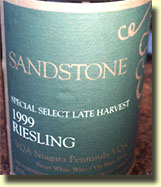 1999 13th Street Wine Co. Sandstone Select Late Harvest Riesling, Niagara Ontario:
This was interesting and displayed evolved aromas. Diesel, lanolin, plastic bag, cooked lemon and garage floor. I don’t think this was designed for this kind of aging. I found it simple in structure without being entirely flabby. Not a favourite for me that night and so I went back to get more Inniskillin. Thanks to Alan Kerr for bringing
this wine and sharing something from the other side of Canada.
1999 13th Street Wine Co. Sandstone Select Late Harvest Riesling, Niagara Ontario:
This was interesting and displayed evolved aromas. Diesel, lanolin, plastic bag, cooked lemon and garage floor. I don’t think this was designed for this kind of aging. I found it simple in structure without being entirely flabby. Not a favourite for me that night and so I went back to get more Inniskillin. Thanks to Alan Kerr for bringing
this wine and sharing something from the other side of Canada.2003 Inniskillin Dark Horse Riesling Ice Wine: Sweet simple nose, overly sweet on the palate, even with the high acidity. It’s what I would call a ‘soda pop’ wine.
1999 13th Street Wine Co. Sandstone Select Late Harvest Riesling: Ahh – the contrast was remarkable. Classic petrol nose, and the RS level and balance of a
decent Auslese. If more Canadian dessert wines were like this, I wouldn’t be so hard on them.
Cheers,
CZ
Hamilton Street Grill
1009 Hamilton Street
Vancouver, BC V6B 5T4
604.331.1511
Alan Kerr's Home Page and Main Index